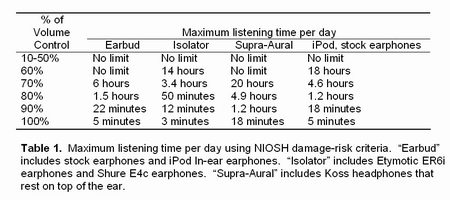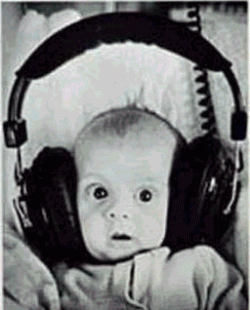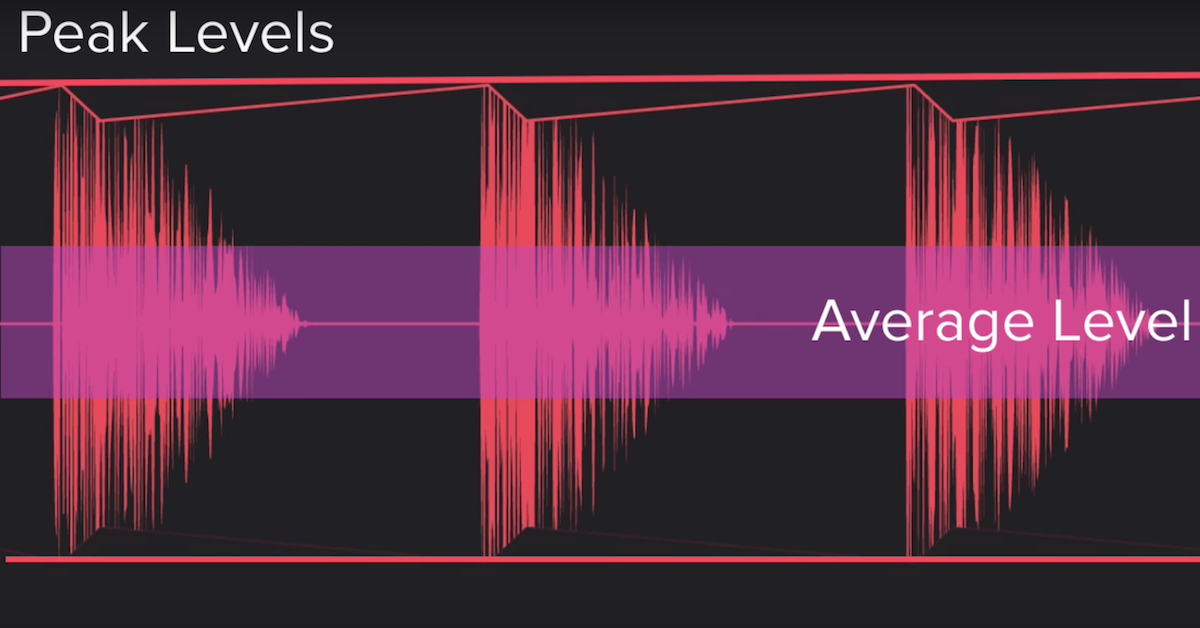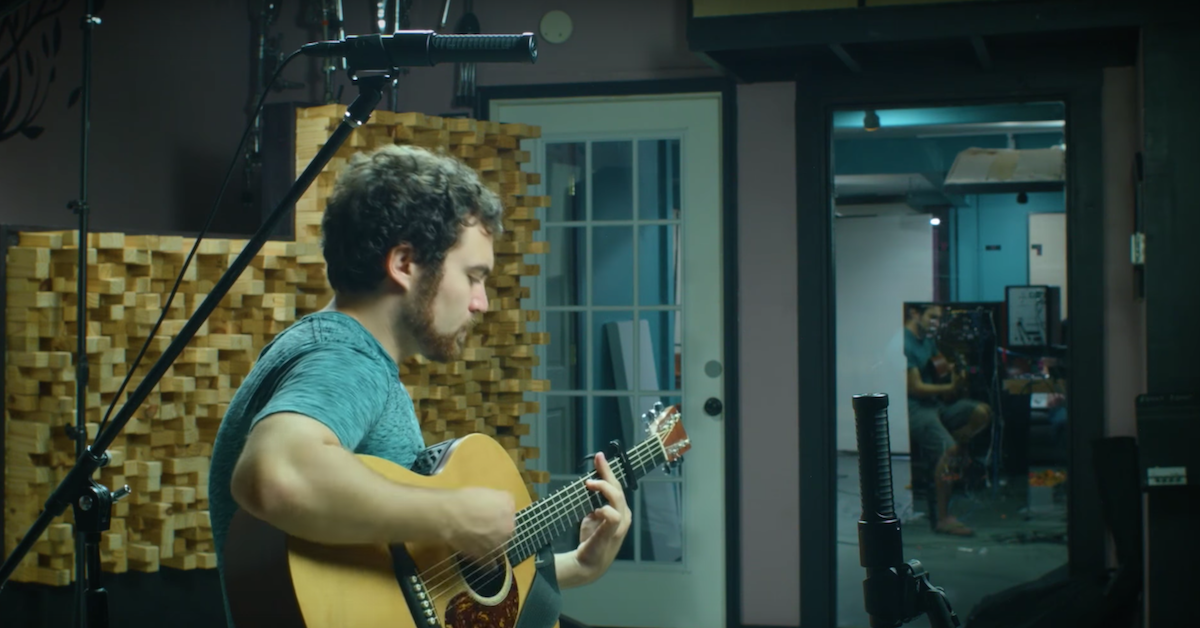Sound Pressure Levels (SPL) – Part 2 of 2
Article Content
In the first part of this series, we discussed which sound levels are actually damaging to our hearing, and some of the health risks associated with exposure to such levels. In part 2, I’ll be talking about a few typical experiences and discussing just how much danger they can pose for an audio professional.
iTinnitus
If you’ll pardon the blatant product naming in the title, I’ll start with discussing the mp3. This is a popular topic which is heavily debated, and yet if you’ve ever taken any sort of public transportion, it’s almost certain you’ll see (or should I say hear) someone with earphones listening to music that you can hear across the bus, train etc.
In my opinion, the portable music player is the biggest culprit to our hearing damage. Either people need to be made fully aware of the risks, or in 5 – 10 years time we’ll begin hearing about more and more cases of hearing loss due to music exposure.
The picture to the right shows the listening times you should be aware of for the various volume’s available on an iPod. The amount of time you spend with your earphones on is going to make a significant difference. If you simply listen to a song or album at night when it’s quiet, then 80% of the volume would be safe, though if it is quiet then you shouldn’t need it that high anyway. As a side note, with the compression evident in most popular music, the exposure to louder levels is arguably more now than listening to an older piece of music. Going back to public transportation and listening to music while commuting, you could be spending up to two hours listening to your mp3 player, and due to the background noise you are probably going to turn it up to 90%, or even 100% to be able to hear the song with the detail you desire. Now if you’re using the standard provided earphones, then from the table we can see that you have either 18 or 5 minutes respectively, so if you have it turned fully up on the train, consider the damage you may be causing.
The amount of time you spend with your earphones on is going to make a significant difference. If you simply listen to a song or album at night when it’s quiet, then 80% of the volume would be safe, though if it is quiet then you shouldn’t need it that high anyway. As a side note, with the compression evident in most popular music, the exposure to louder levels is arguably more now than listening to an older piece of music. Going back to public transportation and listening to music while commuting, you could be spending up to two hours listening to your mp3 player, and due to the background noise you are probably going to turn it up to 90%, or even 100% to be able to hear the song with the detail you desire. Now if you’re using the standard provided earphones, then from the table we can see that you have either 18 or 5 minutes respectively, so if you have it turned fully up on the train, consider the damage you may be causing.
For a more info check out: http://www.physorg.com/news80304823.html
Concerts
 This is something we expose ourselves to that most of us know for a fact can cause hearing damage. That ringing in your ears after a concert is from the high sound levels that your ears have been exposed to for at least an hour solid. Most rock concerts are roughly 90 minutes, not including supporting acts (though these may be at a quieter level). A festival could be considerably more damaging. There is usually a safety level set which varies from country to country. Your position within the venue is important as well though, if you’re at the back of a 4000 seat stadium, depending on the speaker set-up, the sound pressure will have dissipated over a distance. If you’re at the front of the room, then you’ll be taking the full brunt of the pressure.
This is something we expose ourselves to that most of us know for a fact can cause hearing damage. That ringing in your ears after a concert is from the high sound levels that your ears have been exposed to for at least an hour solid. Most rock concerts are roughly 90 minutes, not including supporting acts (though these may be at a quieter level). A festival could be considerably more damaging. There is usually a safety level set which varies from country to country. Your position within the venue is important as well though, if you’re at the back of a 4000 seat stadium, depending on the speaker set-up, the sound pressure will have dissipated over a distance. If you’re at the front of the room, then you’ll be taking the full brunt of the pressure.
As an extreme example: in the Ottawa Citizen the band KISS apparently reached a SPL level of 136 dB at a festival before a safety adviser forced the engineer to reduce the volume, and if you look back at the chart from the first article it’s probably a good job that he did as that kind of levels would be extremely damaging beyond even 5 minutes. Your response to this will depend on your circumstance. If you value your hearing for your career (which you most likely do), then consider not being at the very front, or at least using ear plugs. This is also important if you’re a FOH engineer working at events.
Other Risks
Even football (soccer for my American readers) fans wouldn’t have been safe at this year’s World Cup in Africa as the Vuvuzela made its way to the stadiums. Reaching an impressive 120 dBA the only saving grace is that the ‘player’ of the Vuvu could probably only maintain short blasts at a time, but with over a quarter of the fans using them the sound levels going around those stadiums must have been intense, and also would have lasted 2 or more hours.
Construction and factory work is another risk, as a pneumatic drill for example produces up to 100dB which would allow about 2 hours before damage occurs. If you’re using these ten to be on the safe side you should be wearing some ear plugs of some sort. The Factory Act actually states that any workers in a factory must not be exposed to noise over 85 dBA, and must wear protective headgear if the machines do produce noise above this.
People working in nightclubs should also think about the risk to their hearing, clubs will probably be reaching levels close to concerts and if you’re working there 5 nights a week without earplugs then you’re on a short trip to hearing damage.
Conclusion
Our ears have plenty of ways to tell us that the levels we’re listening to are too loud. You could be the lucky person who doesn’t become damaged despite repeated exposure to dangerous levels, or you could be the unlucky one who’s hearing gets damaged rapidly, with only limited exposure. While there are legal protections in place, it’s ultimately up to you most of the time to think about and respond to the levels.
If you need 100% hearing for your career, you really just cannot risk exposing yourself to sustained high SPL’s. Some earplugs can be cheap, but a good pair of custom fitting earplugs will last a few years and provide you with nice, frequency balanced sound reduction. Concerts and mp3 players are definitely things to watch out for, as you may not realize the damage you are doing until you notice one day your ears are whistling while you’re trying to get that perfect mix.





